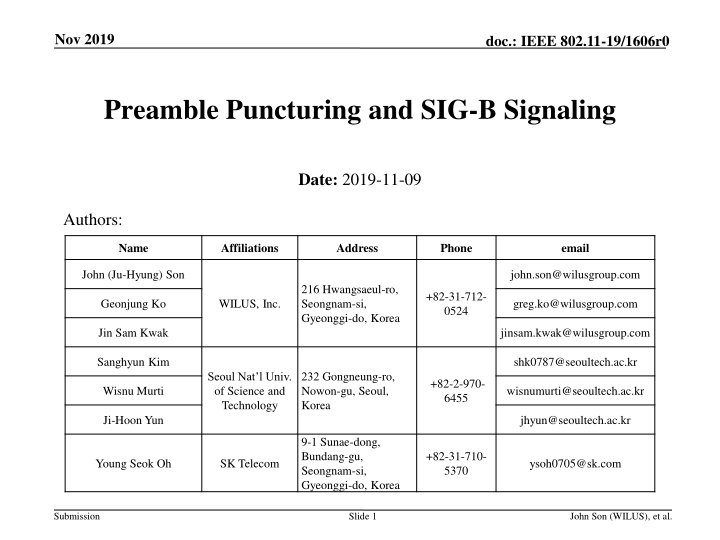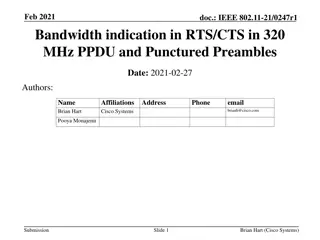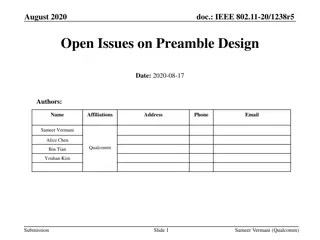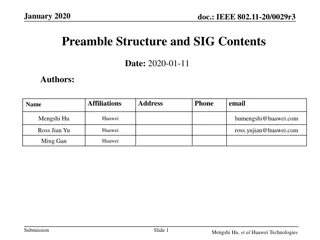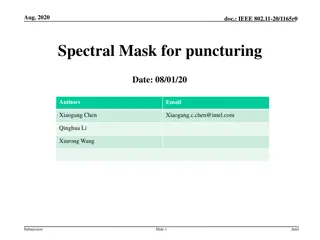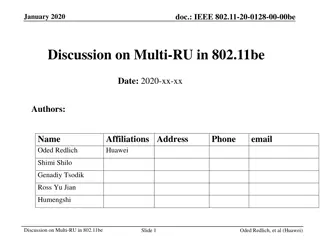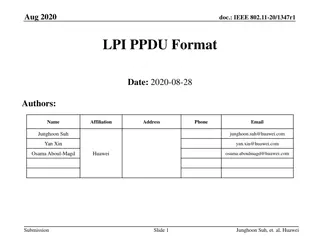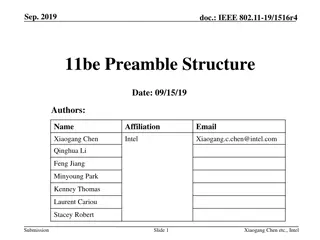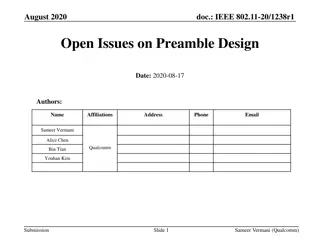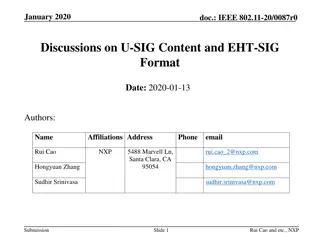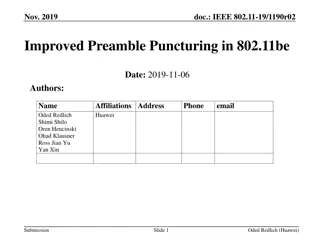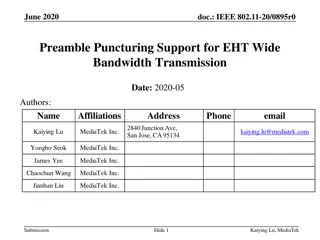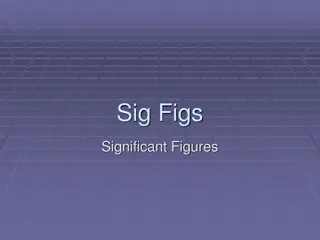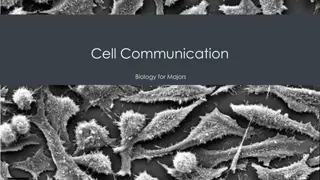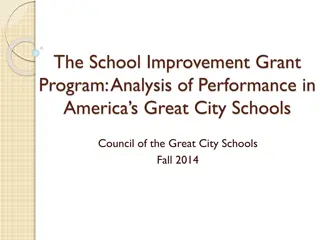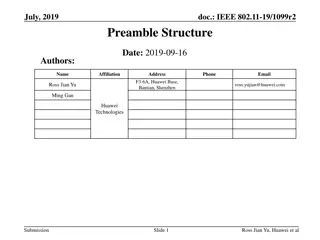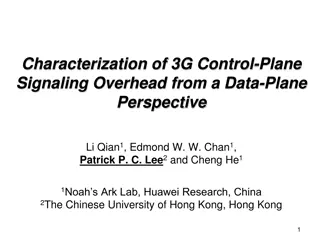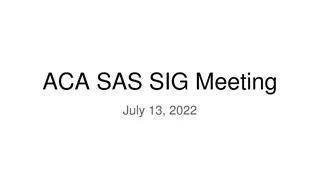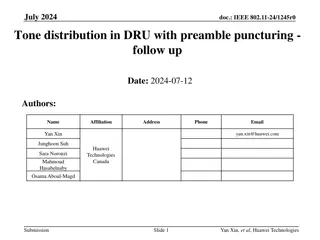IEEE 802.11-19/1606r0 Preamble Puncturing and SIG-B Signaling
EHT, an enhancement to the IEEE 802.11 standard, aims to improve channel access in dense environments using wider bandwidth operation. This document discusses the design considerations for SIG-B content channels and preamble puncturing in the context of EHT's support for 320MHz bandwidth and multiple spatial streams. Various puncturing modes are examined to optimize signaling overhead and channel access flexibility in different environments.
Download Presentation

Please find below an Image/Link to download the presentation.
The content on the website is provided AS IS for your information and personal use only. It may not be sold, licensed, or shared on other websites without obtaining consent from the author.If you encounter any issues during the download, it is possible that the publisher has removed the file from their server.
You are allowed to download the files provided on this website for personal or commercial use, subject to the condition that they are used lawfully. All files are the property of their respective owners.
The content on the website is provided AS IS for your information and personal use only. It may not be sold, licensed, or shared on other websites without obtaining consent from the author.
E N D
Presentation Transcript
Nov 2019 doc.: IEEE 802.11-19/1606r0 Preamble Puncturing and SIG-B Signaling Date: 2019-11-09 Authors: Name Affiliations Address Phone email John (Ju-Hyung) Son john.son@wilusgroup.com 216 Hwangsaeul-ro, Seongnam-si, Gyeonggi-do, Korea +82-31-712- 0524 Geonjung Ko WILUS, Inc. greg.ko@wilusgroup.com Jin Sam Kwak jinsam.kwak@wilusgroup.com Sanghyun Kim shk0787@seoultech.ac.kr 232 Gongneung-ro, Nowon-gu, Seoul, Korea Seoul Nat l Univ. of Science and Technology +82-2-970- 6455 Wisnu Murti wisnumurti@seoultech.ac.kr Ji-HoonYun jhyun@seoultech.ac.kr 9-1 Sunae-dong, Bundang-gu, Seongnam-si, Gyeonggi-do, Korea +82-31-710- 5370 Young Seok Oh SK Telecom ysoh0705@sk.com Submission Slide 1 John Son (WILUS), et al.
Nov 2019 doc.: IEEE 802.11-19/1606r0 Introduction EHT supports wider bandwidth operation EHT PAR [1] includes support for 320MHz bandwidth However, it is hard to expect the whole 320MHz channel to be idle in dense environments EHT needs to enhance the utilization of non-contiguous channel access method [2][3] SIG-B content channel design and Preamble puncturing With support of 320MHz PPDU and 16 spatial streams, the signaling overhead of EHT- SIG-B will be increased [4] EHT may need to extend 11ax s SIG-B content channel design to further distribute signaling overhead to multiple 20MHz channels Therefore, EHT s preamble puncturing modes should also consider SIG-B content channel design In this submission, we discuss various preamble puncturing modes in 320MHz under several SIG-B content channel options To investigate trade-off between signalling overhead and channel access flexibility in various OBSS load environments Submission Slide 2 John Son (WILUS), et al.
Nov 2019 doc.: IEEE 802.11-19/1606r0 Backgrounds: HE-SIG-B content channels HE-SIG-B has two content channels 20 MHz HE MU PPDU contains one SIG-B content channel 40, 80, 160 MHz HE MU PPDU contain two SIG-B content channels The two SIG-B content channels distribute signaling overhead of multiple STAs into two channels However, receivers should be able to decode two SIG-B content channels simultaneously to decode its per-STA information Submission Slide 3 John Son (WILUS), et al.
Nov 2019 doc.: IEEE 802.11-19/1606r0 Backgrounds: HE MU PPDU BW modes BW=4 BW=0 P20 P20 Busy Idle Busy BW=1 P20 P20 Busy Idle or Busy BW=5 BW=2 P20 P20 Busy BW=6 BW=3 P20 P20 Busy HE-SIG-B Channels 1 2 1 2 1 2 1 2 P20 Busy BW=7 P20 Busy HE-SIG-A s BW subfield indicates the overall PPDU BW and SIG-B channel locations HE-SIG-B s RU allocation subfield further indicates each secondary 20MHz s puncturing P20 Busy Busy HE-SIG-B Channels 1 2 1 2 1 2 1 2 The limited puncturing patterns within P80 is to let receivers to decode both SIG-B channels within the Primary 80MHz Submission Slide 4 John Son (WILUS), et al.
Nov 2019 doc.: IEEE 802.11-19/1606r0 EHT-SIG-B content channel options There can be at least three SIG-B content channel options as follows: Option 1 (1, 1, 1, 1): duplicating SIG-B information per 20MHz 1 1 1 1 1 1 1 1 1 1 1 1 1 1 1 1 20 MHz 320 MHz Option 2 (1, 2, 1, 2): duplicating SIG-B information per 40MHz, with different SIG-B information in each 20MHz within the 40MHz 1 2 1 2 1 2 1 2 1 2 1 2 1 2 1 2 40 MHz 320 MHz Option 3 (1, 2, 3, 4): duplicating SIG-B information per 80MHz, with different SIG-B information in each 20MHz within the 80MHz 1 2 3 4 1 2 3 4 1 2 3 4 1 2 3 4 80 MHz 320 MHz Submission Slide 5 John Son (WILUS), et al.
Nov 2019 doc.: IEEE 802.11-19/1606r0 320MHz EHT PPDU BW modes (Option 1) 320MHz Idle P20 Busy 320MHz Preamble Puncturing Idle or Busy P20 EHT-SIG-B (1,1,1,1) 1 1 1 1 1 1 1 1 1 1 1 1 1 1 1 1 20 MHz 320 MHz High signaling overhead vs. Most flexible puncturing pattern The same SIG-B content per 20MHz incurs high signaling overhead May reduce the overhead by using the higher modulation on SIG-B Enables most flexible preamble puncturing patterns in secondary channels May freely occupy idle 20MHz secondary channels if the Primary is idle Submission Slide 6 John Son (WILUS), et al.
Nov 2019 doc.: IEEE 802.11-19/1606r0 320MHz EHT PPDU BW modes (Option 2) 320MHz Idle P20 Busy Idle or Busy P20 Busy 320MHz Preamble Puncturing P20 Busy P20 Busy P20 Busy Busy EHT-SIG-B (1,2,1,2) 1 2 1 2 1 2 1 2 1 2 1 2 1 2 1 2 40 MHz 320 MHz Mid signaling overhead vs. Flexible puncturing pattern The same SIG-B content channel design as 11ax 11ax s preamble puncturing pattern extended upto 320MHz Submission Slide 7 John Son (WILUS), et al.
Nov 2019 doc.: IEEE 802.11-19/1606r0 320MHz EHT PPDU BW modes (Option 3) 320MHz P20 Idle 320MHz Preamble Puncturing Busy Idle or Busy P20 EHT-SIG-B (1,2,3,4) 1 2 3 4 1 2 3 4 1 2 3 4 1 2 3 4 80 MHz 320 MHz Low signaling overhead vs. Inflexible puncturing patterns Different SIG-B information per 20MHz upto 80MHz Receiver should decode four SIG-B content channels in Primary 80MHz, therefore the puncturing is only enabled in the other secondary channels excluding the P80 Submission Slide 8 John Son (WILUS), et al.
Nov 2019 doc.: IEEE 802.11-19/1606r0 Simulation Setup Investigate performances of different preamble puncturing options in OBSS environments EHT BSS 1 BSS operating BW: 320MHz 1AP-1STA, DL only, full buffer MCS 7 fixed, A-MPDU (Max 64 MPDUs), 1 MPDU=1500 Bytes PPDU BW: P20, P40, P80, P160, P320, and preamble puncturing BW based on its CCA results Assume SIG-B overhead of 4 symbols (16us) required per 20MHz in PPDU BW OBSS Among 320MHz channels, 3 OBSSs exist per each 80MHz segment Each OBSS operating BW: 80MHz / 40MHz / 20MHz each Primary channel is randomly chosen within each 80MHz segment PPDU BW: P20, P40, or P80 based on CCA results (no puncturing) Each OBSS has 1AP-1STA, DL only, CBR 10Mbps or CBR 50Mbps MCS 7 fixed, A-MPDU (Max 64 MPDUs), 1 MPDU=1500 Bytes Submission Slide 9 John Son (WILUS), et al.
Nov 2019 doc.: IEEE 802.11-19/1606r0 Simulation Setup (OBSS example) Fixed P20 location EHT BSS (320 MHz) P20 OBSS 1 (80 MHz) 801 802 803 804 OBSS 2 (40 MHz) 401 402 403 404 OBSS 3 (20 MHz) 201 202 203 204 80 MHz 320 MHz 3 OBSS per 80MH segment random P20 location for each OBSS Submission Slide 10 John Son (WILUS), et al.
Nov 2019 doc.: IEEE 802.11-19/1606r0 Simulation Results (EHT BSS s PPDU BW) OBSS Load : 50 Mbps OBSS Load : 10 Mbps 60 60 Option 1 (1,1,1,1) 50 50 Option 2 (1,2,1,2) Percentage (%) 40 40 Option 3 (1,2,3,4) 30 30 Option 0 (No puncturing) 20 20 10 10 0 0 20 MHz 40 MHz 80 MHz 120 MHz 160 MHz 200 MHz 240 MHz 280 MHz 320 MHz 20 MHz 40 MHz 80 MHz 120 MHz 160 MHz 200 MHz 240 MHz 280 MHz 320 MHz PPDU Bandwidth PPDU Bandwidth Option 1 utilizes wide PPDU BW due to its flexible puncturing mode Option 2 also utilizes wide PPDU BW comparable performances to Option 1 However, as OBSS Load increases, Option 2 fails to secure its SIG-B channels in P80, thus failing preamble puncturing transmission (increased 20MHz PPDU percentage) Option 3 shows poor performances from its inflexible puncturing option in Primary 80MHz Option 3 rarely uses preamble puncturing under high OBSS Load in P80 Submission Slide 11 John Son (WILUS), et al.
Nov 2019 doc.: IEEE 802.11-19/1606r0 Simulation Results (EHT BSS s TPUT) 400 350 300 Throughput (Mbps) 250 OBSS Load : 10 Mbps 200 OBSS Load : 50 Mbps 150 100 50 0 Option 1 (1,1,1,1) Option 2 (1,2,1,2) Option 3 (1,2,3,4) Option 0 (No puncturing) Option 1 shows the best channel accessibility, but throughput is lower than Option 2 under small OBSS load due to its SIG-B overhead Option 2 shows good balance in terms of channel accessibility and SIG-B overhead, but the performance is highly affected by OBSS loads Option 3 cannot benefit from its short SIG-B lengths, since it cannot utilize preamble puncturing in OBSS loads Submission Slide 12 John Son (WILUS), et al.
Nov 2019 doc.: IEEE 802.11-19/1606r0 Conclusions We presented several preamble puncturing patterns based on three SIG-B content channel design options Simulation results show that preamble puncturing drastically increase channel access opportunity in dense OBSS environments Among three SIG-B channel options discussed Option 1 (1,1,1,1) and 2 (1,2,1,2) show favorable performance with signaling overhead tradeoffs Option 3 (1,2,3,4) shows low performance due to the limited preamble puncturing pattern in Primary 80MHz We propose to further study preamble puncturing options in 11be Submission Slide 13 John Son (WILUS), et al.
Nov 2019 doc.: IEEE 802.11-19/1606r0 References [1] 11-18-1231-06-0eht-eht-draft-proposed-par [2] 11-19-1242-00-00be-wider-bandwidth-channel-access-in-eht [3] 11-19-1190-00-00be-improved-preamble-puncturing-in-802- 11be [4] 11-19-1099-00-00be-preamble-structure-in-11be Submission Slide 14 John Son (WILUS), et al.
